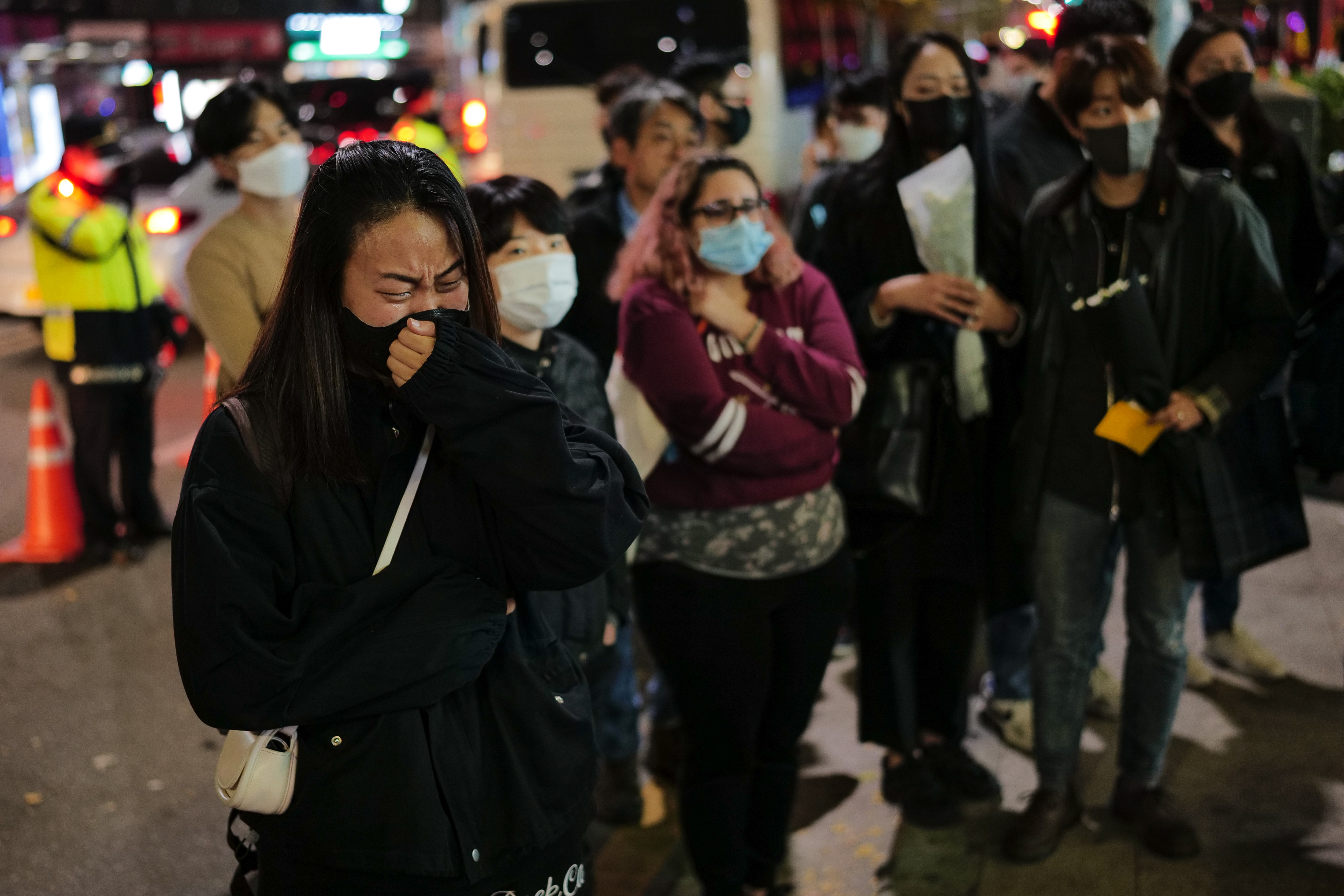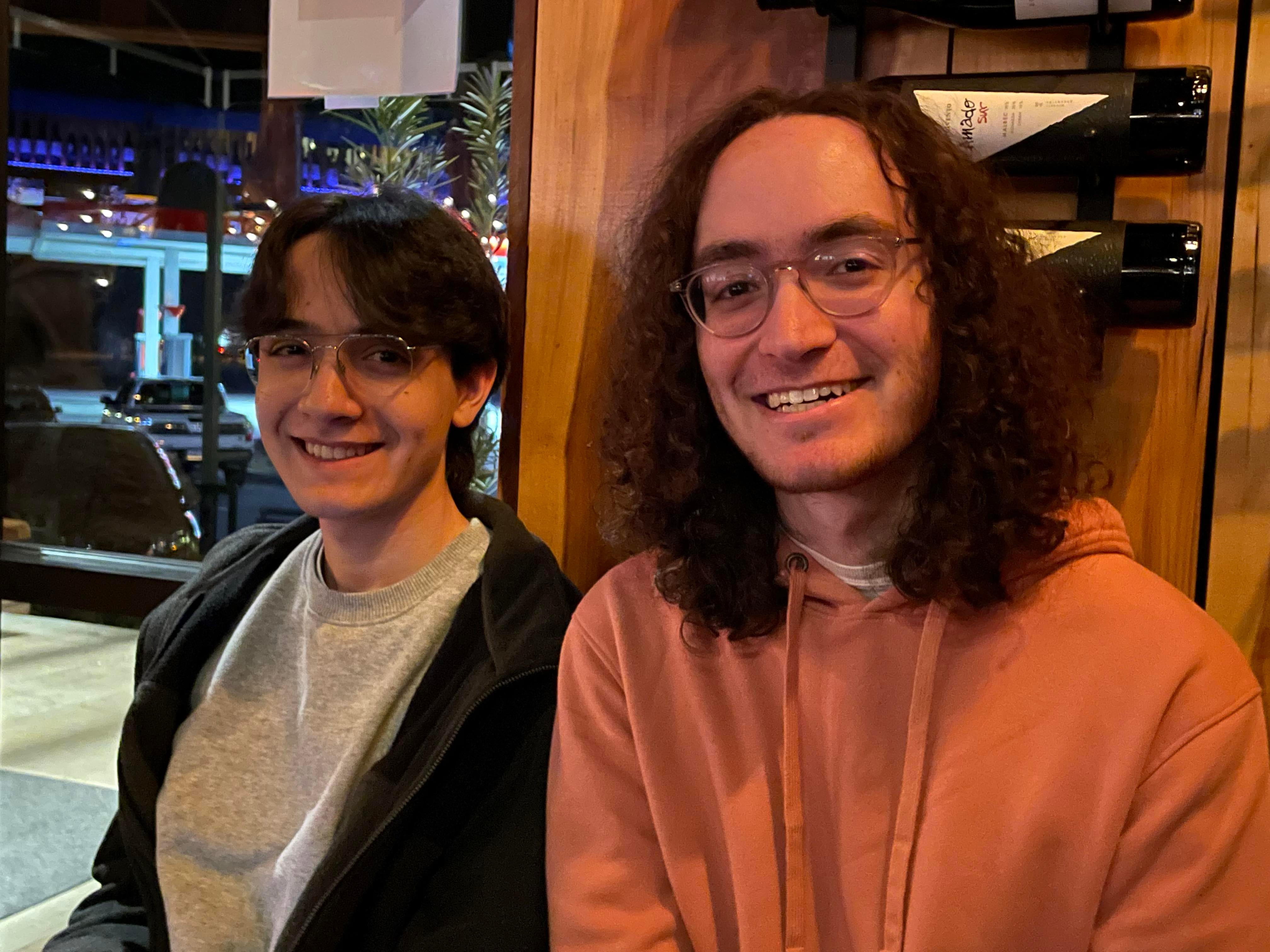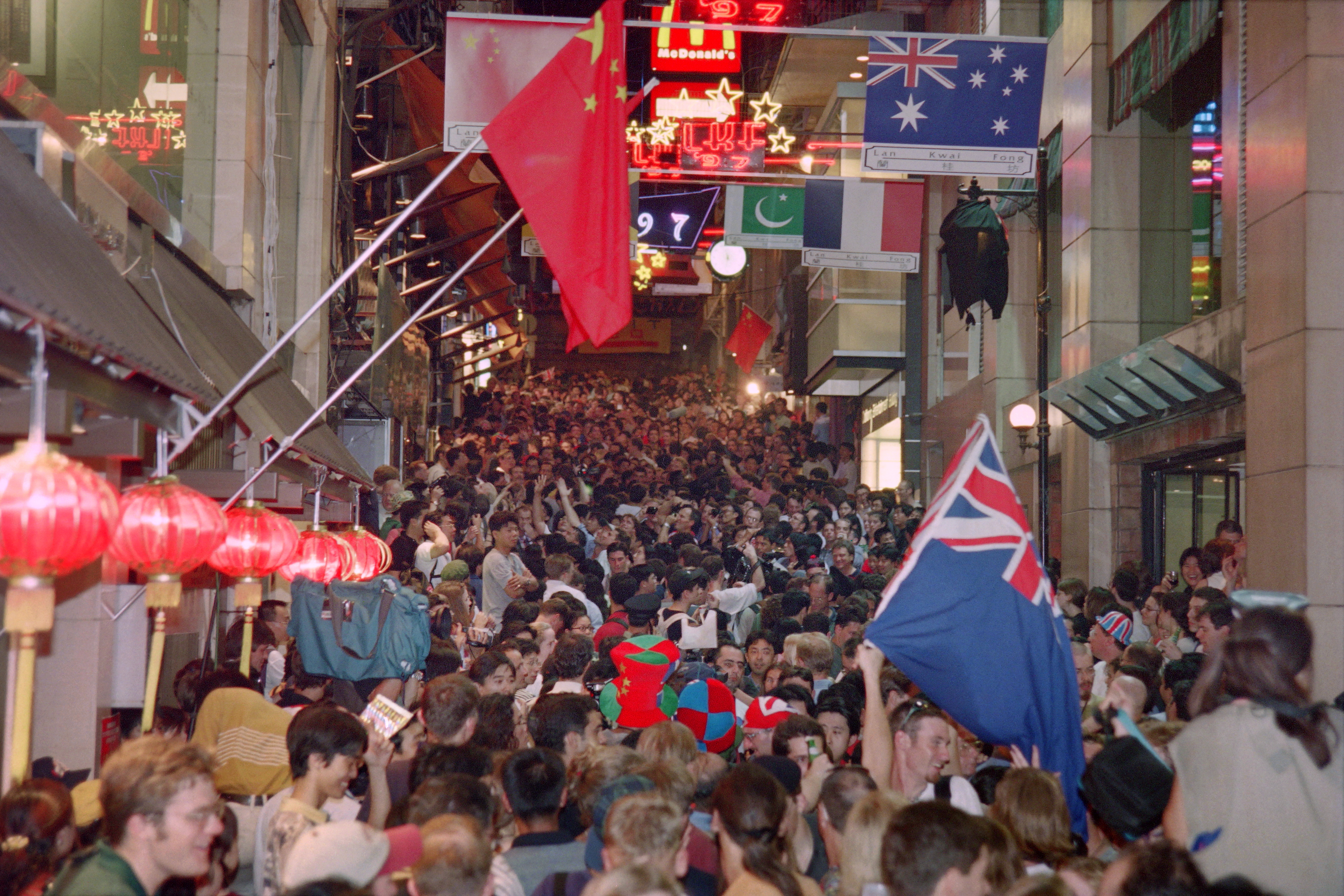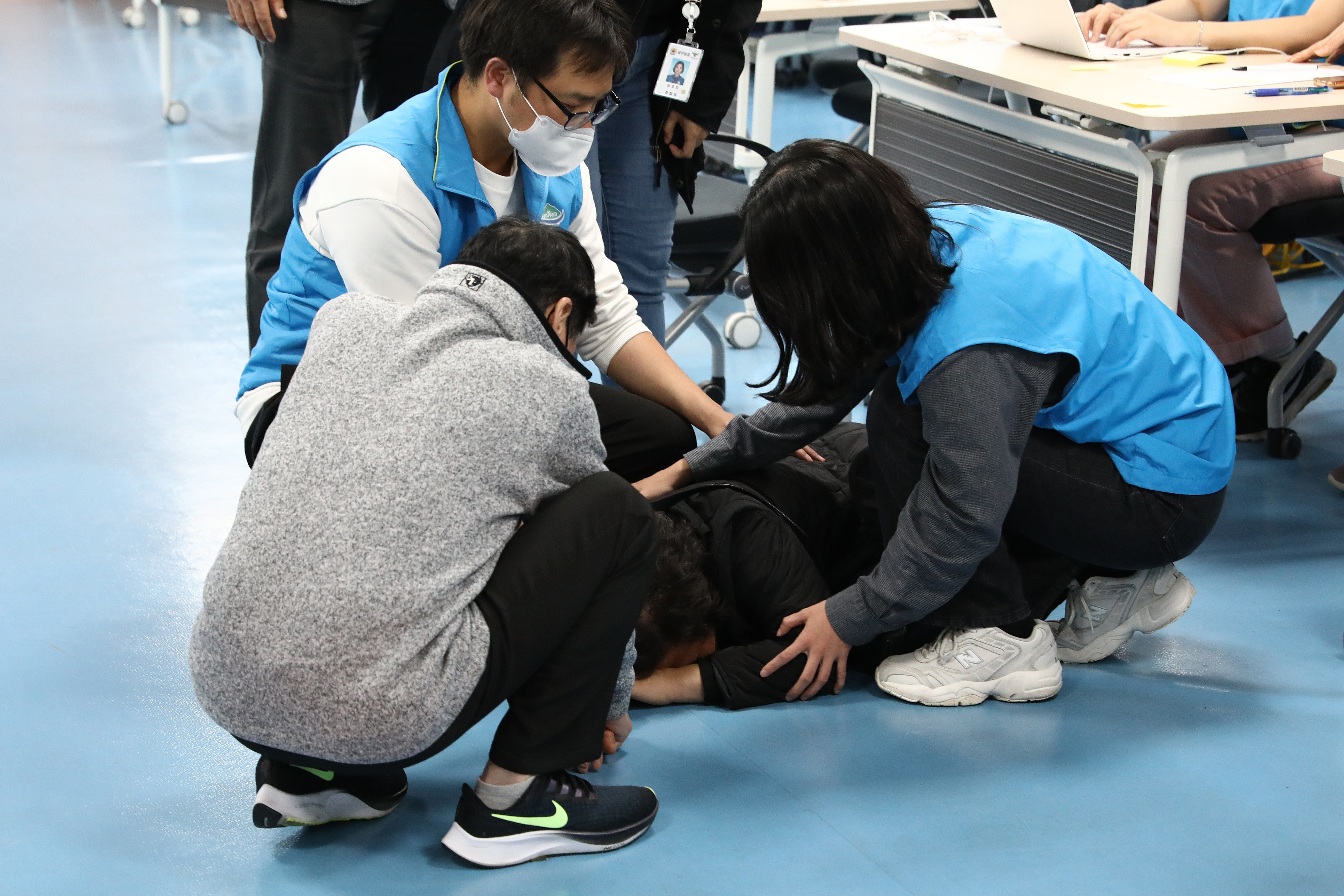SEOUL — The lone police sergeant was in agony. With furrowed brows, he implored the Halloween revelers around him to avoid going down a narrow, slanted walkway that connects the Itaewon bar district to the nearest subway station. He knew something they didn’t: Halfway down that slope, people who fell had formed a dam of bodies, blocking the entire alley—and suffocating under the pressure of the crowd.
“People are dying. Please cooperate!” Kim was seen crying in a video, instructing people to leave. But it was too late.
Videos by VICE
By next morning, on Sunday, Itaewon would be synonymous with the worst crowd disaster in South Korea’s history, and one of the most haunting in the world. At least 156 people, mostly young women, were crushed to death. It wasn’t a stampede—the victims were not trampled to death by a panicked crowd. Many were wedged between strangers and died slowly when their bodies were squeezed so hard that their lungs couldn’t expand to draw in another breath. This could happen even when one is standing upright.
The officer, Kim Baek-gyeom, has been hailed as a national hero for trying to prevent the crowd at the top of the slope from adding pressure—unwittingly—onto people stuck below. Minutes before, he had tried unsuccessfully to pull the bodies out of the dam. He knew the only answer was to get everyone on the other end of the street to back off.
But his desperate pleas for cooperation were also an indictment of South Korean authorities’ colossal failure. They did almost nothing to prepare for the predictable crowd, and they were slow to respond to clear warning signs. Kim was commended partly because there were too few like him in Itaewon that night. In interviews, survivors have pointed out the alarming lack of police presence in the neighborhood, on a night that everyone knew was going to be wild. It was the first Halloween weekend after the country dropped an outdoor mask rule, and the mood to party was palpable.
In an interview with VICE World News, an Itaewon police officer on duty that night described a total lack of awareness of crowd risks among police leaders in the run-up to the disaster.
Critically, just four days before the crush, the Itaewon police substation requested backup from the senior management because it anticipated massive crowds, the officer said, requesting anonymity as they were not authorized to disclose internal matters. They went to work last Saturday expecting help from so-called mobile police, a group of auxiliary police officers often tasked with crowd control at rallies and protests.
“One solid mobile team dispatched would have made a difference. That’s the most regrettable part,” they said.
Even last Halloween, when strict social distancing measures were enforced and crowds were far smaller, mobile police were deployed to the Itaewon entertainment district, they said. The national police agency previously said a special task force was dispatched to the neighborhood on Halloween in the last two years just to ensure compliance with pandemic measures.

South Korea’s police chief has admitted that crowd control that night was inadequate. Police sent just 137 officers to handle a crowd upwards of 100,000. Even Kim, the sergeant, was not supposed to be there; he was answering another call in the neighborhood when he saw the developing crisis.
A police notice, released two days before the crush about measures for a safe Itaewon Halloween, makes no mention of the danger of crowds, warning only of upskirting, sex crimes, theft, traffic congestion, and drug abuse. The officer who spoke with VICE World News said they had prepared for the event for a long time, even procuring blankets to keep drunk people warm, but the officer did not receive any crowd training whatsoever.
For those who lost loved ones in Itaewon, this police negligence is unforgivable.
“They completely failed, and now my son’s dead,” Steve Blesi, whose 20-year-old son, Steven, was one of two Americans killed in the tragedy, told VICE World News.
“To die that way, that’s a horrible death. If I could, I’d die that way instead of my son. If I could get him back, I’d die 100 times that way to get my son back, because I know he suffered.”

In hindsight, the red flags prior to the event were everywhere and unmistakable. But more troubling was how authorities failed to respond to obvious signs of trouble on the night before it was too late.
Visitors to Itaewon reported seeing alarmingly big crowds as early as 5 p.m. Thousands of people dressed in costumes were already swarming the spacious main road just outside Itaewon station.
Like most other Saturday nights, people poured into the restaurants and bars located in the narrow road tucked behind the Hamilton Hotel. The road is named “World Food Street,” a nod to the diversity Itaewon’s nightlife is known for, but today it stands as a landmark to the disaster.
To get to World Food Street from the Itaewon station, one of the shortest paths is through a sloped, even narrower alley along the western exterior wall of the hotel. It’s where a majority of the casualties took place.
Though South Korean law requires that roads be at least four meters wide for pedestrian safety, the alley measures just 3.2 meters toward the bottom after an allegedly illegal terrace extension by the hotel took up more space. The hotel paid more than $350,000 in enforcement fees for nine years of unauthorized extension, according to Kim Tae-soo, a member of the city council, citing data from the Seoul Housing Policy Office.
As the streets became uncomfortably crowded on Oct. 29, people grew increasingly worried. The first call to 112—the country’s emergency number—was made at 6:34 p.m., three and a half hours before the deadly crush.
“I’m so worried to see people going up and down the alley. I think people will get crushed because they keep getting pushed upward even though people can’t come down,” the caller said, according to transcripts released by the police.
The police operator replied, “So you’re worried a crowd-surge accident could happen because it’s hard for people to get by?”
The next call, at 8:09 p.m., made clear just how quickly the situation was deteriorating.
“We can’t move because so many people are being pushed and getting hurt,” the caller said.
At this time, visitors who came by subway reported seeing crowds in the station so big that some simply turned back. Outside the station, streets leading up to the bar district were already so packed that some reported having little control and being pushed around by the crowd.
To experts, this is a telltale sign that the density of people was reaching a dangerous level.
“Anything above four or five people per square meter is dangerous. When there is a sudden movement or surge within a crowd of this density, this causes significant pressure on others in the crowd, and can cause broken ribs and asphyxiation,” said John Drury, an expert on the social psychology of crowd management at the University of Sussex in the UK.
While the triggers of crowd crushes are varied, crowd crushes and stampedes are tragically common.
Every few years since 1994, dozens if not hundreds have died from crowd incidents in the Hajj, the annual Islamic pilgrimage to Mecca. There’s a chilling reason for the high death tolls: When a crowd becomes dense enough, it begins to behave like a fluid. Forces can ripple through a densely packed group of people from the outside, where people have no reason to panic and may unwittingly—and fatally—add to the pressure by approaching.
In the case of the 2015 crush in Mina, Mecca, when as many as 2,400 pilgrims died in a crush, the relentless march of the crowd formed stacks of bodies 10 layers high until the upstream flow stopped. Most people died of compression asphyxiation, but some also had their lungs punctured by broken ribs. The list of human stampedes and crushes is long and growing. The day after the Itaewon disaster, 11 people died in a crowd surge at a packed concert in the capital of the Democratic Republic of the Congo. Two police officers were among those killed.
Back in Itaewon, these deadly signs were becoming apparent to those on the ground, and the urgency of the calls escalated as the evening progressed, explicitly warning of impending disaster.
“I think we are going to get crushed. Everyone is going crazy.”
“I think something big might happen here,” a caller said at 8:33 p.m.
“So many people. They are getting crushed,” the next caller said at 8:53 p.m.
The final call came at 10:11 p.m.
“I think we are going to get crushed. Everyone is going crazy,” the caller said. The distressed caller’s last words were: “Ah! (screaming) Ah! (screaming) The Itaewon back alleyway. Itaewon back alleyway.”
In total, 11 such calls were made prior to the crush. Police said they dispatched officers in response to only four of those, and did not send anyone in the hour leading up to the crush.
Luisa de Oliveira Hochheim, a 21-year-old student from Brazil, remembers seeing about five police officers when she was near the bars behind the Hamilton Hotel minutes before the crush. There was such a mass of people converging that it was practically impossible to move on your own accord, Hochheim told VICE World News.
“When you go with the flow, there’s no turning back,” she said.
But despite visible signs of overcrowding, she was angered that police did nothing to close off the streets, she said. On the main street, cars were still allowed through while people were forced to stay on the packed sidewalks.
Just before the crush, witnesses on World Food Street said many were desperate to turn into the sloped alley to escape the crowd.
“I was there, I was fighting to get out because it was so unpleasant and dangerous,” said Anthony Spaeth, an editor at the Korea JoongAng Daily. Most of the 11 emergency calls to police were made on World Food Street, suggesting there was a dangerous buildup of people.
“I thought, well, once we get out of the main river of people and turn right into that very short alley which empties out into this big broad street, then this will be over. And when we turned right into the alley, it wasn’t over; it got worse,” he said. “The problem was the opposing crowd fighting to get in.”
He managed to get through to the main road 20 minutes before the fatal crush.
The exact circumstances of the moment of the crush are unclear. But it was clear that it began with a crowd collapse halfway down the sloped alley, at around 10:15 p.m., likely after people fell.
Because partygoers were so tightly packed together, their tumble led to others stumbling over like a rippling wave. The crowd screamed for help and tried to cling to anything to steady themselves. But from that point on, there would be no quick escape.
In the narrow part of the alley, at least 50 bodies piled up. Toward the top of that narrow passage, people feeling stuck on World Food Street continued pushing down. Some were unaware of the disaster that was taking place and were trying to get out themselves.
Kim Jae-yun said she lost consciousness in the alley. The 22-year-old was further up the alley from the crush and only learned of the true extent of the disaster after she woke up in the hospital later, she said. She suffered rhabdomyolysis, a potentially fatal condition that results from trauma to her kidney and muscles.
At the bottom of the pileup, people started losing consciousness. But despite rescuers’ efforts to pull at their limbs, few were ever freed from the pile.

What followed was captured in heartbreaking images printed on the front pages of newspapers globally the next day: emergency responders and civilians, some still decked in Halloween outfits, performing cardiopulmonary resuscitation on dozens of bodies on the big street by the subway.
What most news outlets did not show, perhaps because of the graphic nature of the images, was the eerily empty space on the other side of the human wall. For those at the front of the crowd, survival must have seemed within reach. Thus is the nature of crowd crushes: All it takes is one slip to cause a pileup that could block the only way out, and once that happens, there are few things one can do to stop the slow and painful suffocation.
The authorities said they would investigate what the dispatched officers did after they received the emergency calls, but the suggestion that they could have done more disappointed the officers in the Itaewon police substation, the officer told VICE World News.
“Each of us on the front really tried our best, desperately did everything we could to save one more life. It hurt when the chief said we didn’t do enough on the ground,” said the officer, who works in the same substation as Sergeant Kim. “None of us who were at the scene think it’s fair, because we were running around without even noticing black and blue bruises all over our body.”
As news of the Itaewon crowd surge sent shockwaves across the world, Vera Sistenich remembered the night when, as a child, she waited anxiously at home with her parents for information about her missing brother.
He had been partying on New Year’s Eve 1992 at Lan Kwai Fong, Hong Kong’s nightlife center, when things took a dark turn. As people began to leave after the countdown, some lost their footing on the slopes, which were wet from spilled beer and party foam, resulting in a massive pile-on that left 21 dead.
“It was before the days of ubiquitous mobile phones, so my family had a tense few hours,” Sistenich, now an emergency medicine specialist in Australia, told VICE World News. Her teenage brother eventually returned home safe that day. Others were not so lucky.
Sistenich, who studied the incident as a public health student at Harvard University, recalled one of the most important lessons from the tragedy: “The trigger for a deadly stampede can appear to be unclear and trivial, but the conditions allowing for such a simple event to become so lethal are identifiable and preventable.”

The circumstances that led to the crowd disaster in Lan Kwai Fong resembled those in Itaewon last weekend.
“At the Lan Kwai Fong stampede nearly 30 years ago in Hong Kong, narrow streets, steep gradients, slippery streets from alcohol, a possibly inebriated crowd, and live performances that served as crowd magnets, may have all contributed to the fatal New Year’s stampede,” said Satchit Balsari, an assistant professor at the Harvard Medical School.
For Hong Kong, the incident proved to be a pivotal moment. After conducting an independent inquiry, a judge recommended a series of crowd management measures that would successfully help avert such disasters in the decades that followed. More than a heavy police presence, preventing crowds from building up in the wrong places has been key to safety.
Every Halloween, Hong Kong authorities allow only one-way flow in Lan Kwai Fong and use a queueing system to prevent overcapacity. Revelers are also banned from staying in areas considered as choke points, and adjacent roads are closed off to create buffer zones to accommodate a sudden influx of visitors.
None of that was done in Itaewon, where crowds moved in all directions and roads were not closed off to relieve the pressure of the crowd.
“These events can be mitigated, if not prevented,” said Edbert Hsu, an associate professor of emergency medicine at Johns Hopkins University. The key is advanced planning to manage the size and density of the crowd, such as time-gap measures to control movement and limit the number of people at the venue.
Hsu stressed the need to pay attention to bottlenecks, which should be carefully monitored or sealed off altogether. There should also be communication with all emergency response agencies so they are alert to potential accidents and can develop contingency plans, he said.
Alison Hutton, an expert in mass gathering health at the University of Newcastle in Australia, emphasized the need to direct the crowd. “Communicate with the crowd, such as signage to say it’s closed up ahead and consider alternative routes. Make people travel one way only, so there is a flow,” she said.
Having entrance and exit controls at the railway station right next to the alley where the crush occurred could have also helped minimize crowd concentration.
On the night of the crush, Steve Blesi had just returned to his home in the U.S. state of Georgia from grocery shopping with his wife when his brother alerted him to the disaster unfolding in Itaewon.
He knew his son, Steven, who was studying abroad in Seoul, was celebrating Halloween with friends after finishing midterm exams. Just hours ago, he texted him, “I know you’re out and about, but be safe, I love you.”
He began calling his son, but no one picked up.
At around that time in Korea, a similarly urgent message was struggling to reach its intended recipient.
In a shocking revelation on Friday, police said the national head of the force, Yoon Hee-keun, went to bed at around 11 p.m. last Saturday without knowing anything about the crowd crush, some 45 minutes after reports of the disaster flooded news channels and social media. He also missed a text message from an emergency situation officer at 11:32 p.m. and a call 20 minutes later from the officer.
The officer managed to reach the police chief only 14 minutes after midnight. Yoon, who was visiting the city of Jecheon, about 120 kilometers away from Seoul, quickly called the capital’s police chief to order a full mobilization and returned to the city.
Authorities have vowed to fully investigate the disaster and the police’s role in it. The release of the results could take weeks or even months, but what the public has learned so far has painted a picture of disorder inside the police force.
The Korean National Police Agency said it would request a probe into Lee Im-jae, the head of the Yongsan Police Station, which oversees the Itaewon subdivision, and Ryu Mi-jin, a situation monitoring officer at the Seoul Metropolitan Police Agency. Both were accused of failing to promptly report the emergency to senior officials and suspended.
On Wednesday, special investigators raided the headquarters of the Seoul police force, seizing evidence from eight locations, including the Seoul and Yongsan police agencies.
Officials have also blamed one another for failing to stop people from coming out of Itaewon station. The national police say they asked the Seoul subway operator to prevent trains from stopping at Itaewon station to limit the crowds. The company has denied this, saying it only received an official request one hour after the deadly crush.

But thus far, officials have few answers for why they were so ill-prepared for the Halloween event in the first place.
Steve Blesi, the father who lost his son in the crush, said the authorities “completely failed at their job.”
“The head of police should be fired. Whoever is in charge in that district—fired. They should resign in disgrace.”
Blesi tried calling his son for two hours until a police officer answered, telling him it was one of 175 phones found at the site of the disaster. Later that night, around midday in South Korea on Sunday, staff at the U.S. Embassy delivered the bad news after asking him, “Are you sitting down?”
Among the 156 confirmed dead, 130 were from South Korea. The 26 foreign nationals came from 14 countries, including Iran, China, Russia, Japan, and Australia. At least five high school students and one middle schooler died.
Those who lived but witnessed the tragedy said they were traumatized.
“If you go to sleep, you’re back in Itaewon,” said Hochheim, who passed piles of bodies after escaping the crowd. “And if you go to school, you can see your friends don’t want to go to school because someone they know died.”
The Itaewon officer remembers how citizens followed their lead in frantically performing CPR on the bodies carried out onto the main street. The officer recalled thinking, “We have to do it until the end. We have to do it. We must stick it out.” The officers at Itaewon substation were all “traumatized to some degree, feeling extremely guilty of not being able to save more people,” the officer said.
On Thursday, a family who lost their loved one in the disaster walked into the Itaewon police substation, which sits just across the main street from the site of the crush. They didn’t come to vent. “They told us we did our best and we can let it go,” the officer said.
Sowon Lee contributed translation.
Follow Junhyup Kwon, Hanako Montgomery, Rachel Cheung, and Alan Wong on Twitter.







